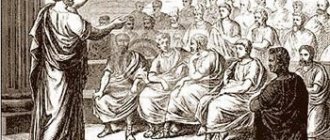Rhetoric as science and art
The rhetoric of speech arose in ancient times and at the same time two of its directions emerged:
- rhetoric as the science of demonstrative speech;
- rhetoric as the art of eloquence.
The definition of modern rhetoric brings these divergent views together:
The subject of its study is speech, which can be convincing and beautiful, influencing the listener and delivering aesthetic pleasure.
Rhetoric as a science teaches the rules of its construction, organization of communication, creation and expression of one’s thoughts in words. Rhetoric as an art deals with developing the skills to speak and write beautifully, to master words perfectly, and to arouse reciprocal interest in the listener.
A little history
The art of oratory known today dates back to Ancient Greece. Although his story began much earlier. But it was the contemporaries of Hellas who attached great importance to this and even created a science that taught such skill.
Ancient speakers used all sorts of techniques to stage a speech. The mastery of eloquence is based on the principles of effective speaking and persuasion. Aristotle dedicated his works “Rhetoric” to this art, which are known throughout the world. He believed that the success of a speech is determined by the character of the speaker, his audience and the characteristics of his speech. He considered the main advantages of speech to be euphony and clarity. And the quality of the report is influenced by the style of presentation, arguments and richness of language. The following names of great orators remain in history: Pericles, Thomas Aquinas, Gorgias and Demosthenes.
The Romans skillfully used the science created by the Greeks. In the 2nd century BC, there were humanitarian schools on the territory of the republic, which trained future politicians. Classical disciplines were divided into the following stages:
- Classicism.
- Competent letter.
- Studying eloquence and writing speeches.
Mark Quintilian wrote about the study of oratory in those days in his work “Rhetorical Instructions.” He was a teacher and a renowned trial lawyer. Quintillian studied the qualities that a speaker should have. In his books, he gives specific recommendations on how to improve speech, work on facial expressions and master logic. An outstanding theorist of oratory was Marcus Cicero. His speeches were striking in their logic and well-chosen argumentation.
The achievements of ancient times were also used by orators in medieval times. Famous orators of those times include Thomas Aquinas, Pierre Abelard and Martin Luther. M. Lomonosov did a lot for the development of oratory in Russia. Thanks to him, educational institutions with instruction in Russian appeared. Many writers were also excellent speakers. These are Belinsky, Saltykov - Shchedrin and Herzen.
The emergence of a special Russian style was facilitated by the speeches of judicial figures of the 19th century - Plevako, Arsenyev and Koni.
Fundamentals of Rhetoric
Rhetoric will tell you everything about public speech, its stages, goals, sources of material, methods of presentation, means of speech influence, as well as the requirements for the speaker’s personality.
Today, the ability to competently build communication is a necessary condition for success in the social life of every person. For those who are directly involved in speaking in front of an audience, this skill is the key to professional excellence.
Let's find out what an effective public speech should be.
The speaker’s speech will be successful if it organically combines logic and emotionality, information content and expressiveness. It is good if it is not read, but pronounced in the form of live communication with listeners.
Application of oratory
Knowledge of the theory of public speaking plays a big role in career advancement. Similar rules will be useful to any person working in modern organizations.
If you do not have knowledge about public speaking, relationships with subordinates and negotiations will not develop. Possession of eloquence may be needed in the following situations:
- Speak at a management meeting and present a report. In this case, a graphic presentation is additionally used.
- Report among colleagues. The speed of decision-making and work results depend on the ability to formulate thoughts. The presentation should be clear and concise.
- Spontaneous business communication. The ability to maintain a business conversation is valued by clients and employees within the team.
- Interview. The culture of speech makes a favorable impression when meeting.
Skillful conversation has a positive impact on your career. Managers respect employees who are educated, outgoing, and good communicators.
Types of rhetoric
Currently, there is the following classification of rhetoric by type:
- socio-political (parliamentary and rally speeches, campaign speeches), which is characterized by emotionality, and often pathos, for persuasion and motivation to action;
- academic (scientific review, educational lecture), with arguments and facts, structured, sometimes monotonous and indifferent, as soon as the speaker loses touch with the audience, reading a prepared text;
- social and everyday (welcome, table, anniversary address, toast), for the most part simple and sincere, not distinguished by perfect logic and clear structure, but sincere and kind-hearted;
- judicial (accusatory, defensive), strictly reasoned and balanced, determining the fate of a person;
- theological-church (sermon, official church speech) uplifting spiritually, bringing joy, instructing for good;
- military (address-order, instructive, inspiring speech), specific, strict, strengthening patriotic feelings, nurturing love for the Fatherland;
- diplomatic (speech at international negotiations and conferences), characterized by a high degree of responsibility for every word spoken;
- business (business as well as telephone conversations), the obligatory elements of which are accessibility, expressiveness, and literacy;
- dialogical (interview, argument, discussion), which requires practicing the skills of proper dialogue.
Help from “Foma”. Samples of Russian oratorical classics
Famous judicial figures of the second half of the 19th - early 20th centuries, F.N. Plevako, A.F. Koni, P.S. Porokhovshchikov, were distinguished by their judicial eloquence; academic eloquence - university professors, historians T. P. Granovsky, V. O. Klyuchevsky, philologists I. I. Davydov, F. I. Buslaev, I. I. Sreznevsky - in the 19th century, N. I. Konrad, V. V. Vinogradov - in the twentieth century. Many church speakers were examples of spiritual eloquence: Metropolitan Philaret (Drozdov), Holy Righteous John of Kronstadt. We find examples of political eloquence among the Kiev princes, and among the associates of Peter the Great (Feofan Prokopovich), and in the proclamations of Alexander I, written on the occasion of Napoleon’s invasion, and in the speeches of figures of the early twentieth century - Stolypin, Witte and many others.
On the screensaver there is a fragment of the TEDxSydney photo
The connection between rhetoric and other humanities
Rhetoric is a philological science. But being a multifaceted teaching, it is closely intertwined with a variety of areas of knowledge related to the effectiveness of communication, and also uses methods of non-speech sciences.
Rhetoric is associated with:
- logic - the science of correct thinking;
- grammar, which studies the rules of speech;
- poetics - the study of the means and techniques of artistic expression;
- a culture of speech that obliges us to comply with the norms of the literary language;
- stylistics, which studies the patterns of language functioning in the process of speech communication.
The use of psychological methods makes it possible to explain human behavior and understand his state of mind.
The connection between rhetoric and ethics provides knowledge of the laws of morality and morality of society. The union of rhetoric and philosophy allows us to raise the solution of any problem to a higher moral and spiritual level.
Oratory in the modern world
Modern oratory is built on different disciplines. These are psychology, rhetoric, philosophy and aesthetics. All sciences are interconnected. Logic, grammar and rhetoric are of particular importance:
- Mastery of rhetoric provides coherence and sequence of thoughts in a speech.
- Grammar is reflected in the correct use of words and their configurations.
- Logic is responsible for the semantic coherence and thoroughness of speech.
Since ancient times, correct speech has been an important component of success. Building a career in various fields of activity depends on the ability to convince and persuade your clients, customers or colleagues. Important skills include the ability to control the timbre and intonation of the voice depending on the situation. The correct intonation when pronouncing phrases matters. Speakers work hard to improve their speech culture.
It must be remembered that oratory talent is rarely given at birth. The ability to deliver convincing and powerful speeches must be constantly practiced.
Development of rhetoric
How can one learn all the intricacies of this science? If you really want this, use our recommendations:
- Hone your diction. Speak slowly, pronouncing each word clearly, observe pauses and even breathing.
- Read aloud and retell what you read. Try to convey the meaning in your own words, constructing your speech yourself.
- Learn to tell the most ordinary stories that happen to you in a captivating way. Feedback from listeners will tell you how well you are doing.
- Prepare a speech on a topic close to you. Prepare key phrases for this and improvise as you pronounce it.
- Train your memory. Learn poems and excerpts from literary works by heart and let it become a habit.
- Determine your type of information perception. Some people learn visual information better, while others find it easier to remember what is said out loud. Use this knowledge about yourself to get the best results.
- Organize your studying with pauses and breaks in mind. Let it also be regular, and not just once in a while.
- If you have a fear of public speaking, practicing these very speeches helps a lot. Practice with your loved ones - they will understand and will definitely support you.
Modern Rhetoric: 7 Great Speeches
Over the past few years, the art of rhetoric has experienced a second youth. Thanks to the development and popularity of YouTube (and especially the TED conference), it is possible to watch the best speakers of our time. We have collected several speeches by famous people that you can enjoy, and also provide you with short analyzes of each of them from a rhetorical perspective.
But first, a little theory. There are four laws of modern rhetoric that every speaker tries to adhere to.
Law of harmonizing dialogue
Effective verbal communication is possible only with dialogical interaction between the participants in communication, therefore it is necessary to turn any monologue into a dialogue in order to awaken the thoughts and feelings of listeners.
The law of orientation and promotion of the addressee
It requires that the listener, with the help of the speaker, be oriented “in the space” of speech and that he feels that together with the speaker he is moving towards the goal. To do this, the speaker must use words in his speech that indicate the order of events (first, second, etc.), summary words (therefore, so), connective sentences (let's move on to the next question), etc.
The law of emotional speech
It requires that the speaker not only think, but also feel, experience emotionally what he is talking about, and be able to express his emotions in speech.
Law of Pleasure
It implies that speech is effective when it gives pleasure to the listener, which, at the same time, should not harm the meaning of the speech.
And now we present to your attention the most interesting public speeches in recent years.
Amanda Palmer "The Art of Asking", 2013
Amanda Palmer is an American singer, performer and songwriter. She was involved in theater in her youth, which was very evident during her TED talk in 2013. A million people watched her performance on the first day.
What techniques did Amanda use and why did they work? The first thing she does is put a plastic box on stage, stand on it and show the audience a daisy. Such an unusual beginning attracts viewers because they are not used to something like this. Therefore, Amanda uses the effect of surprise.
Then, before she even begins speaking, she is silent for about two seconds. This is where her passion for theater comes into play. The dramatic pause literally rivets the viewer to the chair. Thanks to this pause, Amanda seems to make it clear: “I don’t need you, but you need me.”
Throughout the performance, Amanda uses props that are on stage. She follows Anton Chekhov's injunction: “If at the beginning of the play there is a gun hanging on the wall, then it must fire.” Thanks to this, the viewer gets a feeling of fullness and professionalism of the performance. He already understands that he is not dealing with just another speaker, but with one of the best.
Manosh Vasudevan “Pull less, bend more”, 2021
With this speech, Manosh took first place in the public speaking competition.
Manosh, like Amanda Palmer, pauses at the beginning. We will see later that all speakers use this technique.
He immediately identifies the problem, and in such a way that no one in the room doubts - this is really important. To further emphasize it, he asks a rhetorical question: “Have you ever had problems?”, which emotionally connects the topic of the speech with the audience.
It is also worth noting that Manosh very harmoniously combines information and entertainment, preventing the performance from slipping into buffoonery or a boring lecture.
Ernesto Sirolli “Do you want to help someone? Shut up and listen!”, 2012
The charismatic and eloquent Ernesto Sirolli really captivated the audience in 2012, despite the fact that the topic of his speech initially interested few people. His gestures, pauses, images and metaphors are simply amazingly polished, and his energy is mesmerizing.
Sirolli begins his speech with fairly dry facts, because the topic is very serious. Therefore, he periodically entertains the audience so that they do not get bored and jokes well, achieving balance. And the expressiveness of the Italian, as we have already said, is fascinating.
In addition to techniques, of course, you should not forget about what idea you want to convey to the listener. Sirolli puts it in the title - and, in fact, never leaves it during the entire 17-minute performance. He knows that this is the glue that keeps speech from falling apart.
Tony Robbins "Why We Do What We Do", 2007
Tony Robbins has talked about this performance several times, so we know how he prepared for it.
First and most importantly, he is not used to speaking for 20 minutes (TED requirement), so his goal was to energize the audience and motivate him, which he does very well.
Thanks to his strong voice, his performances always attract everyone's attention. It is worth saying again that Robbins is first and foremost a motivator, he loves to ignite passion in people with the help of words. He does not need initial pauses and this makes him significantly different from previous speakers.
Throughout his speech, he asks many rhetorical questions, emotionally involving listeners. In the video at 19:40, Tony accidentally or intentionally does what every public speaker dreams of, he gets the audience to ask him to continue. And despite TED's strict rules, he is allowed to do this.
Radislav Gandapas “Two life scenarios”
Business coach Radislav Gandapas has been speaking in public for the second decade, so he has plenty of experience. He is considered one of the most famous speakers in the post-Soviet space.
In this talk, Gandapas doesn't use many slides, using just one, around which the whole talk revolves. This is unusual, it forces the listener to concentrate on the idea that the speaker wants to convey. In addition, he dilutes his performance with a lot of stories.
Simon Sinek "On the generation of the second millennium", 2021
Despite the fact that this is not exactly a public performance, it was impossible not to include it on our list. Many people consider this speech to be one of the most motivating speeches of the last few years.
Simon Sinek is a well-known motivational speaker and writer, the author of two popular books on the topic of leadership and achieving goals, the creator of the concept of inspiring leadership, which, according to Sinek, is followed by all successful global companies and business leaders.
Although this is not a scripted speech, it is valuable to us because it shows how easy it is to improvise when you have a passion for the topic you are talking about.
Simon does not lose the audience's attention, despite the fact that he speaks almost non-stop for 14 minutes. Why? He constantly changes something: the tone of his voice, speed, volume. At the same time, he endlessly sprinkles metaphors and analogies, which is very well absorbed by people who, it would seem, should already be tired. Also, one cannot help but mention the notorious passion: even a minute of this speech is enough to understand that Simon enjoys the topic he is talking about. This cannot be faked and the public sees it.
Will Stephen "Best Public Speaking", 2014
And finally, a video that will probably make you laugh, but at the same time will give you more food for thought than all previous performances.
Yes, despite the humor, this is actually a very good performance, even if at first glance it makes no sense. However, on the second and third too. However, it uses the best oratory techniques that attract attention and make the audience stay until the end. But this is the main reward for a speaker.
Did you like the article? Join our communities on social networks or our Telegram channel and don’t miss the release of new useful materials: TelegramVKontakteFacebook
We also recommend reading:
- Storytelling
- Best of the year. Part three
- Rhetoric: how to make your speech effective?
- Preparing and delivering a speech
- 4 speaker mistakes: reasons why speeches are not successful
- How to Impress Your Audience: Tips from Brian Tracy
- Tips for working effectively with your audience
- Oratory: exercises
- Rhetorical hand
- Techniques for a successful presentation: a selection of useful materials
- How to make the meaning of a speech clear
Key words:1Rhetoric







